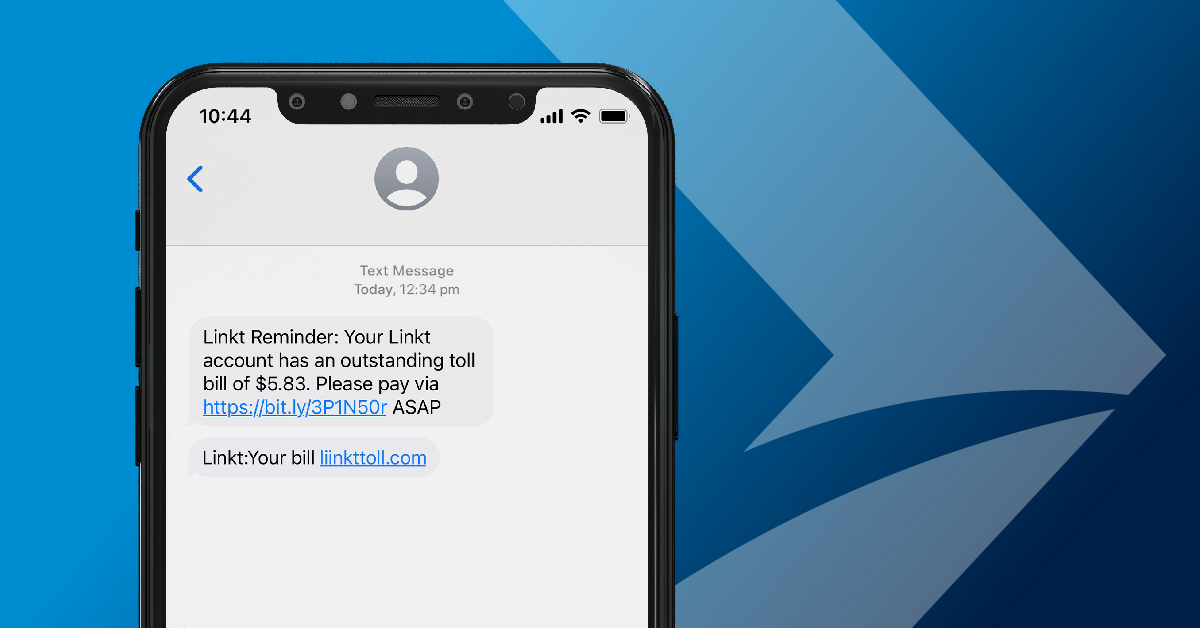How to avoid E-Toll scams
 Have you or a loved one received an email or text that says you owe money for tolls? Before you respond, make sure the message is legitimate.
Have you or a loved one received an email or text that says you owe money for tolls? Before you respond, make sure the message is legitimate.
Unfortunately, there has been a growing number of E-Toll scams nationwide. So, it's always best to double-check any communications claiming to be from toll payment services, such as E-Toll or Linkt. Here’s how to keep you and your loved ones safe from these scams.
What is an E-Toll scam?
When you use a toll road, a camera captures a photo of your car’s vehicle registration plates as you enter and exit the roadway. Or, if you use an E-Toll tag, an electronic device records where you get on or off the toll road. In about four weeks, you’ll receive your toll bill in the mail — not an email or text message — that shows what you owe for travelling on the toll road.
How does an E-Toll scam work?
An E-Toll scam uses a tactic called phishing to steal from you. They impersonate legitimate toll road payment services, including Linkt or E-Toll, sending you and other motorists messages that you have overdue toll road bills or insufficient funds in their payment accounts.
These messages appear genuine. Scammers steal brand logos and fonts from toll payment services — even using URLs that look similar to the toll payment service’s actual web address. They’ll even use the words “Linkt” or “E-Toll” to make you believe they’re the real thing.
All these ruses can trick you into clicking a link or attachment that takes you to their own website, not the genuine toll payment service. Once there, they ask for your financial and personal details to process your payment — but it’s a payment to them, not the payment service.
They don’t only take the money you send them for payment. They can also steal your financial and personal data to siphon even more money out of your account in the future.
But there’s good news. You can outfox these scammers if you follow a few simple rules.
How can I avoid an E-Toll scam?
First, don’t open emails or texts from your toll payment provider in the first place. Instead, go to the official toll payment site or app, log in, and look for any messages in your inbox.
A legitimate toll payment service will notify you by mail or in a secure message that you can only access after you log in.
Be aware that E-Toll, Linkt, and other legitimate payment portals will only text you if you’ve given them permission to send SMS messages. They’ll only contain links to the official website and will never ask you to click on them to pay your bill.
However, if you’ve already opened the message or email, look carefully at the body of the message. If something seems off, take time to investigate.
Look for the following red flags:
- Grammatical and spelling errors
- Errors in the URL (if in doubt, type in the actual toll payment service’s web address and compare them)
- Vague, urgent, or threatening language that urges immediate action without providing specific details.
What can I do if I’m taken in by an E-Toll scam?
First, contact your bank or other financial institution to tell them about the scam.
You can also report the incident to Scamwatch, another helpful government resource that can assist scam victims.
Additionally, be sure to contact your phone service provider if the initial contact with the scammer occurred by phone. They can provide information to the state police to help track down the guilty party.
Finally, don’t be afraid to talk to friends and family about your experience. The more you speak to others about how scammers work, the better chance they can avoid becoming victims of scams themselves.
This article is intended to provide general information of an educational nature only. This information has been prepared without taking into account your objectives, financial situation or needs. Therefore, before acting on this information, you should consider its appropriateness having regard to these matters and the product terms and conditions. Terms, conditions, fees, charges and credit criteria apply. We do not recommend any third party products or services and we are not liable in relation to them. Any links to third party websites are for your information only and we do not endorse their content. Information in this article is current as at the date of publication.

